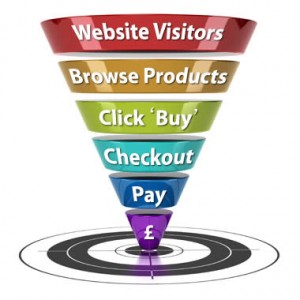Improving your website’s sales performance
What is Conversion Rate Optimisation?
Most people who run a website, online business and even SEO’s in general tend to focus on one key metric – website traffic.
Increasing visitor numbers is in many cases the only indicator that many understand. The premise is that if visitors to my website increase then my sales will go up.
This can be true to a point, the basic law of averages will support that. However, the real key to online success, and what Five Geckos Digital Marketing Strategy really tries to tackle and improve for clients is conversion rate optimisation.
 Take the following scenario: Website A is currently receiving 500 visitors on a daily basis and sells 80 products. Website B receives 5,000 visitors on a daily basis and also sells 80 products. Which would you rather be?
Take the following scenario: Website A is currently receiving 500 visitors on a daily basis and sells 80 products. Website B receives 5,000 visitors on a daily basis and also sells 80 products. Which would you rather be?
Surprisingly, most people I speak to automatically want ‘more traffic’ and go for 5000 visitors – website B, which has a conversion rate of 1.60% (80 units / 5000 x 100). Website A in contrast has a conversion rate of 16% (80/500 x 100). Despite a much lower traffic volume, Website A is converting at a higher rate giving a much higher return on investment (ROI). The ideal scenario would of course be a higher conversion rate as well as increasing traffic which should be the ultimate goal of any Digital Strategy.
So how can Conversion Rates be improved?
Find the ‘roadblocks’
Think of the journey through your website as a route. Starting at the point a visitor enters your website and ending at the point of conversion, whether that is a sale, sign-up, download or any other action important to your business. At what point do visitors encounter a ‘roadblock’ and either turn back, or worse, leave your site? Probably the most common area for drop-off’s are the product pages themselves. Providing information and product images that are not clearly laid out, overly long, complicated and confusing forms to submit or just too many calls-to-action and options confusing visitors as to what it is they are actually supposed to be doing next.
All this data can usually be found with a little digging through your web analytics tool such as Google Analytics. Identify these roadblocks and make them a priority to improve. Segment the data to find common and technical issues; are users of a particular browser , screen size, device etc dropping off more than others or is it at a particular page or call-to-action that may be affecting the conversion rate. Once you identify these bottlenecks – fix them! You may be surprised as to just how effective even the smallest tweaks can make to your online conversion rates.
Test, test and test again…
What you think may be the problem may not actually be the issue at all. Put aside gut feelings and look at the data. Once you have identified the roadblocks and have a plan to change and fix make sure you test the changes against the original. You can either test them one at a time or use an A/B/Multivariate testing tool to test different versions in varying combinations (that’s what Five Geckos do here), however you do it, make sure you look at the resulting data to make an informed decision as to whether the changes have made the intended impact. Take the ‘winning’ page and make further changes to keep your site evolving and growing your conversion rate – this is what Conversion Rate Optimisation is.
Speed test…
The single most affecting factor to most drop-off’s is site speed. Studies show that 30% of people just will not wait 4 seconds for a page on your website to load – they’ll be hitting that back button or leaving for a faster site. Visitor experience needs to be factored in and accounted for. Faster websites and a better visitor experience is a known factor for increasing visitor engagement, interaction and ultimately your website’s conversion rate.